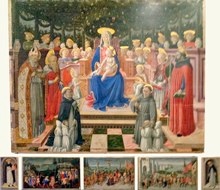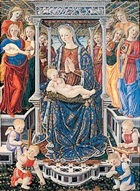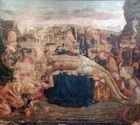

Giovanni di Pier Matteo Boccati, who was born in Camerino, was documented as an associate of Filippo Lippi in Florence in 1443. He became a citizen of Perugia in 1445, on the basis of an application in which he announced his intention to establish a workshop in the city.
Although Giovanni Boccati subsequently maintained a home in Perugia, he worked in a number of places in Italy. He was documented in Padua in 1448, although the length of his stay there is unknown. He also arbitrated in a dispute in Spoleto in 1454. Federico da Montefeltro commissioned him to paint the frescoes of famous men in the Camera Picta of the Palazzo Ducale, Urbino, possibly just before his second marriage in 1459.
Galleria Nazionale, Perugia
The first three works are in Room 9 of the Galleria Nazionale, and the fourth is on deposit there (see link below)
Madonna della Pergolata (1446-7)

This important altarpiece is the earliest surviving work signed by Giovanni Boccati and one of the first altarpieces in Umbria with an undivided central field. The Confraternita di San Domenico bought the altarpiece at a very high price in 1446: their archives record that “Messer Angiolo”, who had originally commissioned it, no longer wanted it. They paid for minor additions to the work (see below) in 1497, the date given in the inscription on the base of the throne.
Francesco Mancini (see below) has suggested that “Messer Angiolo” was, in fact, Angelo Geraldini di Amelia, who studied law at the Studium and then became its first non-Perugian Professor of Law (1444-6). During this period, he also acted as rector of the Collegio di San Gregorio (Sapienza Vecchia) and of the Collegio di San Girolamo (Sapienza Nuova). SS Gregory and Jerome feature in the altarpiece, and it might have been intended for one of the college chapels. (Another altarpiece of similar format, which was commissioned for the Sapienza Nuova in 1456 from Benozzo Gozzoli, is now also in the gallery).
The confraternity bought the altarpiece after its rejection by Messer Angiolo and adapted for use in the Oratorio di San Domenico. It subsequently suffered serious damage and Giannicola di Paolo was commissioned to restore it in 1519. It was dismembered in 1780 and was moved to the Galleria Nazionale in 1863, when the oratory and adjoining Convento di San Domenico were converted for use as a barracks.
The main panel depicts the Madonna and Child with the Doctors of the Church (SS Ambrose, Jerome, Augustine and Gregory) and a choir of angels under a flowery pergola. In the foreground, SS Dominic and Francis commend four of the brothers: it seems likely that earlier figures were replaced by representations of the penitent members of the confraternity when they took over the commission from Messer Angiolo. (St Francis would still have been appropriate because the confraternity was closely associated with the Confraternita di San Francesco).
The predella panels depict:
-
✴St Thomas Aquinas;
-
✴three fine scenes from the Passion (the capture of Christ; the road to Calvary; and the Crucifixion); and
-
✴St Peter Martyr.
It is likely that the two Dominican saints in the predella were also added after the change of commissioner.
Madonna dell’ Orchestra (ca. 1450)

The gallery notes suggest that the altarpiece was originally in the friars’ church of San Simone del Carmine. Fabio Marcelli (see the page on the artist) has suggested that it might have been the fruit of the link between Giovanni Boccati and the scholar Tommaso Pontano, both of whom moved to Perugia from Camerino in the 1440s. Tommaso Pontano formed an association of lecturers from the Facoltà delle Arti of the University of Perugia in 1441 that originally met in the church of Santa Maria del Mercato. When this church was demolished in 1545, the association moved to San Simone del Carmine and it is possible that the Madonna dell’ Orchestra moved with them.
The altarpiece depicts the Madonna and Child enthroned, with an angelic orchestra. The throne is set in a meadow, and two angels kneel at its base to pick flowers. A goldfinch seems to peck the finger of the baby Jesus: the goldfinch is a symbol of the Passion because it feeds among thorns.
Gonfalone della Pietà (1479)

Panels from San Tommaso (15th century)
These panels, which are attributed to Giovanni Boccati, came from the Dominican Monastero di San Tommaso. The panels, which are of similar dimensions, both depict the Madonna with musical angels:
-
✴The panel of the Madonna del Latte, in which the Madonna breast feeds the baby Jesus, was first documented when it was moved to the Accademia di Belle Arti in 1810.
-
✴The heavily repainted panel of the Madonna dei Raccomandati, in which the Madonna shields a number of kneeling lay people under her cloak, remained in the choir of the church until ca. 1880, when it was moved to the Galleria Nazionale.
Both panels are now in the deposit of the gallery. They are illustrated in schedules 32-3 in the catalogue entry by Mauro Minardi referenced below.
Orvieto
St Sabinus Altarpiece (1473)
The altarpiece, which is dated by inscription, was documented in the Oratorio di San Savino in Palazzo Carvajal (which was then called Palazzo Pietrangeli) in 1829, and was first attributed to Giovanni Boccati in 1866. A document in the archives of Orvieto records that Antonio Simoncelli made a payment to Giovanni Boccati in 1473, and this almost certainly relates to this altarpiece.
The altarpiece was placed on the art market in Florence in 1895.
-
✴The main panel and the original frame (minus the predella panel) were sold to the Szpmvszeti Muzeum (Museum of Fine Arts), Budapest.
-
•The panel itself depicts the Madonna and Child enthroned, with SS Juvenal, Sabinus of Canosa, Augustine and Jerome, against a gold background. There are two standing angels on each side of the Madonna, and two sit on the marble pavement at her feet, playing stringed instruments. The face of the Madonna seems to have been repainted later in the 15th century, perhaps by Antonio del Massaro da Viterbo, il Pastura.
-
•The upper cornice of the frame contains three painted angels with garlands, and there is a figure of Christ the Redeemer in the lunette above.
-
✴The predella panels depict four scenes from the life of St Sabinus:
-
•St Sabinus talking to his friend, St Benedict on Monte Cassino about Totila's entry into Rome (now in the Museo Thyssen-Bornemisza, Madrid);
-
•St Sabinus recognises Totilla (once in the Mario Lanfranchi collection, Rome);
-
•the Archdeacon Vindemius attempts to poison St Sabinus (now in the Galleria Nazionale, Urbino); and
-
•death of St Sabinus (once in the Spiridon collection, Paris).
There is some confusion as to the original location of the altarpiece:
-
✴Some sources indicate that it came a chapel in the Duomo that was dedicated to St Sabinus of Canosa, but there is no record that any such chapel ever existed.
-
✴More recent scholars suggest that it was painted for the Oratorio di San Savino in Palazzo Carvajal. Cardinal Girolamo Simoncelli, the son of Antonio Simoncelli, built the palace in 1548, and Caravajal dei Caravajal-Simoncelli built the oratory in 1571. It is possible that an earlier palace and oratory on this site belonged to the Simoncelli family at the time that the altarpiece was commissioned.
-
✴A more likely candidate for its original location seems to me to be San Giovenale, near Palazzo Carvajal, given that:
-
•the altarpieces features St Juvenal as well as St Sabinus;
-
•San Giovenale contained relics of St Sabinus and was documented as SS Giovenale e Sabino in 1314; and
-
•St Sabinus features in a number of other works in the church; and
-
•one of the above is a second altarpiece (ca. 1490) with the Madonna and Child enthroned an SS Juvenal, Sabinus of Canosa, with three scenes from the life of St Juvenal in its predella .
-
It is possible that Antonio Simoncelli commissioned the altarpiece for the church, and that it reverted to his descendants before 1807, when Palazzo Carvajal was sold to the Pietrangeli family.
Read more:
M. Boskovits, “Early Italian Painting, 1270-1470: Thyssen-Bornemisza Collection ”, (1990) London, pp 48-53
F. Mancini, “Benedetto Bonfigli”, (1992) Perugia: the identity of “Messer Angiolo” is discussed in note 82, pp 30-1.
M. Minardi, “Giovanni di Pier Matteo Boccati” in
A. De Marchi (Ed.), “Pittori a Camerino nel Quattrocento” (2002) Jesi, pp 206-92, and particularly catalogue items 4, 9, 27-31 and 32-33
F. Marcelli, “Boccati ‘Umanista’: Proposte Intorno al Soggiorno Perugino”, in A. de Marchi and P. Falaschi (Eds.), “I da Varano e le Arti”, (2003) Camerino
L. Guidi di Bagno, “La Pittura del Tardo Quattrocento e Inizi del Cinquecento nelle Chiese e nei Palazzi di Orvieto”, in
C. Benocci et al. (Eds), “Storia di Orvieto: Quattrocento e Cinquecento” (2010) Pisa, Volume II (p 415 for the document of 1473)

